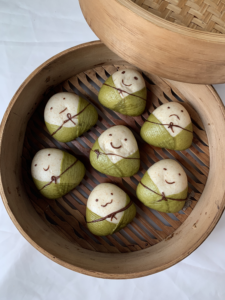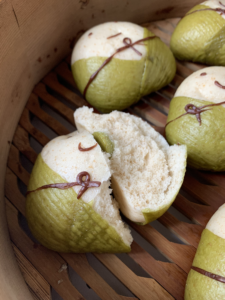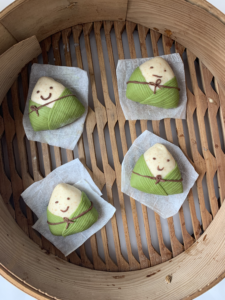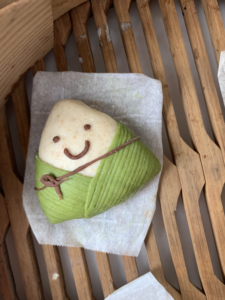端午節快樂!Happy Dragon Boat Festival!
In the summers when we’re in Taiwan, we usually get to eat some really delicious 粽子(zongzi). When we’re in Minnesota for the summer I have happy memories of squatting on the kitchen floor making zongzi, watching my mom wrap them with ease while I spill sticky rice and break the leaves.
If you’re like me and your zongzi making skills are less than subpar, these festive zongzi steamed buns are a fun way to celebrate the holiday!
![]()
![]()




Recipe notes:
The shaping may take a little while, especially for the first few. If you’re worried about the buns over-proofing while you’re working (especially if you’re working in a hot environment), place the buns into the fridge as you finish shaping them, then take them all out to do the final proof.
For a video demonstration on shaping, check out my instagram.
Three factors that can cause your steamed buns to wrinkle/deflate:
- The dough is too wet. Steamed bun dough is generally on the dryer side compared to many other bread doughs. The dough should not feel wet or sticky in any way. If in doubt, add more flour.
- Your buns over-proofed. When your buns proof for too long, they will completely deflate when you steam them. In the summer your proof time may be shorter, and in winter you proof time may be longer.
- The dough is under-kneaded. It’s very important to knead bun dough until smooth, if you didn’t knead enough and the dough still looks shaggy, your buns will be wrinkly.
Dough
170g all purpose flour
30g whole wheat flour
20g sugar
1/8 tsp salt
1/3 tsp active dry yeast
120ml warm water
colors:
1/4 tsp matcha powder
1/4 tsp cocoa powder
To make the dough:
- Add warm water and active dry yeast to a large mixing bowl. Let sit for 5 minutes.
- Add the rest of the dough ingredients (except for matcha and cocoa) and mix to combine. Knead until a soft and smooth dough forms. The dough should not be sticky or wet. If it is, add more flour.
- Weigh out 50g of dough for the leaves. Add matcha powder and knead until evenly incorporated. Cover and set aside.
- Weigh out 15g of dough. Add cocoa powder and knead until evenly incorporated. You can adjust the amount of cocoa based on how dark you would like it to be.
- You should have three balls of dough: white, green, and brown. Let dough rise for 2 hours.
- Punch down the white dough. If the dough is wet or sticky, knead in an additional 10g of flour until it’s smooth and does not stick to your hands.
- Divide white dough into eight equal pieces (about 35g each). Knead each piece to knock out any trapped air bubbles, then shape into a ball. Cover and let rest for 15 minutes.
- Divide green dough into 8 equal pieces, about 6g each. Cover to keep the dough from drying out.
To shape the buns:
- To make the triangular shape of the zongzi, bring the tips of your index fingers together so your two fingers form two sides of a triangle, and press against the sides of the bun. Pinch each corner and shape until you get an equilateral triangle. Repeat with all 8 pieces of white dough to get 8 triangles.
- To make the leaves, take a piece of your green dough and split in half. Use a rolling pin to flatten into an oval shape (it doesn’t have to be perfect!). Use a plastic bench scraper or dull edge of butter knife to make vertical indentations down the length of the dough. Space the indentations close together.
- Dab a bit of water on the backside of the leaf (the side that does not have indentations) and adhere the leaf to one point of the triangle, laying it diagonally across the point and wrapping it around the back. Repeat with the other leaf on the second point of the triangle, so the two leaves overlap in the middle.
- Repeat this process with the rest of the green dough.
- To make the string, take a small piece of brown dough and roll into a long string against your work surface. Wrap it around the middle of the bun. Use the same method to roll out another long string, form into the shape of a knot and place on the string you already wrapped.
- To make the face, pinch a bit of brown dough and roll into eyes and mouth. You can use a toothpick to help arrange the face more precisely. If your decorations are not adhering, use a bit of water to help them stick.
- Once all the buns are shaped, place in a bamboo steamer and let proof for 30-45 minutes, until they look slightly puffy.
- Steam on medium high heat for 15 minutes. Turn off the heat and let sit for 10 minutes before removing the lid. These buns are best eaten hot out of the steamer, slathered with 豆腐乳 (fermented bean curd).
